
Giant redwood, Lady Bird Johnson Grove, Redwood National Park. The coastal redwood, or simply 'redwood', is the tallest tree on Earth, reaching a height of 379' and living 3500 years or more. It is native to coastal California and the southwestern corner of Oregon within the United States, but most concentrated in Redwood National and State Parks in Northern California, found close to the coast where moisture and soil conditions can support its unique size and growth requirements.
Species: California redwood, Coast redwood, Giant redwood, Sequoia sempervirens
Location: Redwood National Park, California
Image ID: 25833
Species: California redwood, Coast redwood, Giant redwood, Sequoia sempervirens
Location: Redwood National Park, California
Image ID: 25833

Giant redwood, Lady Bird Johnson Grove, Redwood National Park. The coastal redwood, or simply 'redwood', is the tallest tree on Earth, reaching a height of 379' and living 3500 years or more. It is native to coastal California and the southwestern corner of Oregon within the United States, but most concentrated in Redwood National and State Parks in Northern California, found close to the coast where moisture and soil conditions can support its unique size and growth requirements.
Species: California redwood, Coast redwood, Giant redwood, Sequoia sempervirens
Location: Redwood National Park, California
Image ID: 25834
Species: California redwood, Coast redwood, Giant redwood, Sequoia sempervirens
Location: Redwood National Park, California
Image ID: 25834

Giant redwood, or coastal redwood, is the tallest tree on Earth, reaching a height of 379' and living 3500 years or more. It is native to coastal California and the southwestern corner of Oregon within the United States, but most concentrated in Redwood National and State Parks in Northern California, found close to the coast where moisture and soil conditions can support its unique size and growth requirements.
Species: California redwood, Coast redwood, Giant redwood, Sequoia sempervirens
Location: Redwood National Park, California
Image ID: 25836
Species: California redwood, Coast redwood, Giant redwood, Sequoia sempervirens
Location: Redwood National Park, California
Image ID: 25836

Ferns grow below coastal redwood and Douglas Fir trees, Lady Bird Johnson Grove, Redwood National Park. The coastal redwood, or simply 'redwood', is the tallest tree on Earth, reaching a height of 379' and living 3500 years or more. It is native to coastal California and the southwestern corner of Oregon within the United States, but most concentrated in Redwood National and State Parks in Northern California, found close to the coast where moisture and soil conditions can support its unique size and growth requirements.
Species: California redwood, Coast redwood, Giant redwood, Sequoia sempervirens
Location: Redwood National Park, California
Image ID: 25840
Species: California redwood, Coast redwood, Giant redwood, Sequoia sempervirens
Location: Redwood National Park, California
Image ID: 25840

Giant redwood, Lady Bird Johnson Grove, Redwood National Park. The coastal redwood, or simply 'redwood', is the tallest tree on Earth, reaching a height of 379' and living 3500 years or more. It is native to coastal California and the southwestern corner of Oregon within the United States, but most concentrated in Redwood National and State Parks in Northern California, found close to the coast where moisture and soil conditions can support its unique size and growth requirements.
Species: California redwood, Coast redwood, Giant redwood, Sequoia sempervirens
Location: Redwood National Park, California
Image ID: 25841
Species: California redwood, Coast redwood, Giant redwood, Sequoia sempervirens
Location: Redwood National Park, California
Image ID: 25841

Giant redwood, Lady Bird Johnson Grove, Redwood National Park. The coastal redwood, or simply 'redwood', is the tallest tree on Earth, reaching a height of 379' and living 3500 years or more. It is native to coastal California and the southwestern corner of Oregon within the United States, but most concentrated in Redwood National and State Parks in Northern California, found close to the coast where moisture and soil conditions can support its unique size and growth requirements.
Species: California redwood, Coast redwood, Giant redwood, Sequoia sempervirens
Location: Redwood National Park, California
Image ID: 25842
Species: California redwood, Coast redwood, Giant redwood, Sequoia sempervirens
Location: Redwood National Park, California
Image ID: 25842

Giant redwood, Lady Bird Johnson Grove, Redwood National Park. The coastal redwood, or simply 'redwood', is the tallest tree on Earth, reaching a height of 379' and living 3500 years or more. It is native to coastal California and the southwestern corner of Oregon within the United States, but most concentrated in Redwood National and State Parks in Northern California, found close to the coast where moisture and soil conditions can support its unique size and growth requirements.
Species: California redwood, Coast redwood, Giant redwood, Sequoia sempervirens
Location: Redwood National Park, California
Image ID: 25843
Species: California redwood, Coast redwood, Giant redwood, Sequoia sempervirens
Location: Redwood National Park, California
Image ID: 25843

Giant redwood, Lady Bird Johnson Grove, Redwood National Park. The coastal redwood, or simply 'redwood', is the tallest tree on Earth, reaching a height of 379' and living 3500 years or more. It is native to coastal California and the southwestern corner of Oregon within the United States, but most concentrated in Redwood National and State Parks in Northern California, found close to the coast where moisture and soil conditions can support its unique size and growth requirements.
Species: California redwood, Coast redwood, Giant redwood, Sequoia sempervirens
Location: Redwood National Park, California
Image ID: 25846
Species: California redwood, Coast redwood, Giant redwood, Sequoia sempervirens
Location: Redwood National Park, California
Image ID: 25846
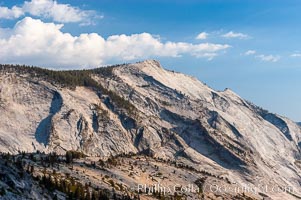
Clouds Rest viewed from Olmsted Point. Clouds Rest is one of the most massive -- if not the singlemost massive -- granite monoliths in the world. A vast lobe of Mesozoic-era granodiorite magma cooled to rock and was gradually uplifted to its present altitude of 9926 ft. Later, glaciers cut it into its present shape.
Location: Yosemite National Park, California
Image ID: 09964
Location: Yosemite National Park, California
Image ID: 09964

The bisons massive head is its most characteristic feature. Its forehead bulges because of its convex-shaped frontal bone. Its shoulder hump, dwindling bowlike to the haunches, is supported by unusually long spinal vertebrae. Over powerful neck and shoulder muscles grows a great shaggy coat of curly brown fur, and over the head, like an immense hood, grows a shock of black hair. Its forequarters are higher and much heavier than its haunches. A mature bull stands about 6 1/2 feet (2 meters) at the shoulder and weighs more than 2,000 pounds (900 kilograms). The bisons horns are short and black. In the male they are thick at the base and taper abruptly to sharp points as they curve outward and upward; the females horns are more slender.
Species: American bison, Bison bison
Location: Yellowstone National Park, Wyoming
Image ID: 13134
Species: American bison, Bison bison
Location: Yellowstone National Park, Wyoming
Image ID: 13134

Coastal redwoods and Douglas firs dominate the Muir Woods National Monument north of San Francisco. Coast redwoods are the worlds tallest living species and second-most massive tree (after the giant Sequoia), reaching 370 ft in height and 22 ft in diameter. Muir Woods National Monument, Golden Gate National Recreation Area, north of San Francisco.
Species: Coastal redwood, Pseudotsuga menziesii, Sequoia sempervirens
Location: Muir Woods National Monument, California
Image ID: 09074
Species: Coastal redwood, Pseudotsuga menziesii, Sequoia sempervirens
Location: Muir Woods National Monument, California
Image ID: 09074

Coastal redwoods and Douglas firs dominate the Muir Woods National Monument north of San Francisco. Coast redwoods are the worlds tallest living species and second-most massive tree (after the giant Sequoia), reaching 370 ft in height and 22 ft in diameter. Muir Woods National Monument, Golden Gate National Recreation Area, north of San Francisco.
Species: Coastal redwood, Pseudotsuga menziesii, Sequoia sempervirens
Location: Muir Woods National Monument, California
Image ID: 09075
Species: Coastal redwood, Pseudotsuga menziesii, Sequoia sempervirens
Location: Muir Woods National Monument, California
Image ID: 09075

Coastal redwoods and Douglas firs dominate the Muir Woods National Monument north of San Francisco. Coast redwoods are the worlds tallest living species and second-most massive tree (after the giant Sequoia), reaching 370 ft in height and 22 ft in diameter. Muir Woods National Monument, Golden Gate National Recreation Area, north of San Francisco.
Species: Coastal redwood, Pseudotsuga menziesii, Sequoia sempervirens
Location: Muir Woods National Monument, California
Image ID: 09076
Species: Coastal redwood, Pseudotsuga menziesii, Sequoia sempervirens
Location: Muir Woods National Monument, California
Image ID: 09076

Coastal redwoods and Douglas firs dominate the Muir Woods National Monument north of San Francisco. Coast redwoods are the worlds tallest living species and second-most massive tree (after the giant Sequoia), reaching 370 ft in height and 22 ft in diameter. Muir Woods National Monument, Golden Gate National Recreation Area, north of San Francisco.
Species: Coastal redwood, Pseudotsuga menziesii, Sequoia sempervirens
Location: Muir Woods National Monument, California
Image ID: 09077
Species: Coastal redwood, Pseudotsuga menziesii, Sequoia sempervirens
Location: Muir Woods National Monument, California
Image ID: 09077

Coastal redwoods and Douglas firs dominate the Muir Woods National Monument north of San Francisco. Coast redwoods are the worlds tallest living species and second-most massive tree (after the giant Sequoia), reaching 370 ft in height and 22 ft in diameter. Muir Woods National Monument, Golden Gate National Recreation Area, north of San Francisco.
Species: Coastal redwood, Pseudotsuga menziesii, Sequoia sempervirens
Location: Muir Woods National Monument, California
Image ID: 09078
Species: Coastal redwood, Pseudotsuga menziesii, Sequoia sempervirens
Location: Muir Woods National Monument, California
Image ID: 09078

Coastal redwoods and Douglas firs dominate the Muir Woods National Monument north of San Francisco. Coast redwoods are the worlds tallest living species and second-most massive tree (after the giant Sequoia), reaching 370 ft in height and 22 ft in diameter. Muir Woods National Monument, Golden Gate National Recreation Area, north of San Francisco.
Species: Coastal redwood, Pseudotsuga menziesii, Sequoia sempervirens
Location: Muir Woods National Monument, California
Image ID: 09079
Species: Coastal redwood, Pseudotsuga menziesii, Sequoia sempervirens
Location: Muir Woods National Monument, California
Image ID: 09079

Coastal redwoods and Douglas firs dominate the Muir Woods National Monument north of San Francisco. Coast redwoods are the worlds tallest living species and second-most massive tree (after the giant Sequoia), reaching 370 ft in height and 22 ft in diameter. Muir Woods National Monument, Golden Gate National Recreation Area, north of San Francisco.
Species: Coastal redwood, Pseudotsuga menziesii, Sequoia sempervirens
Location: Muir Woods National Monument, California
Image ID: 09080
Species: Coastal redwood, Pseudotsuga menziesii, Sequoia sempervirens
Location: Muir Woods National Monument, California
Image ID: 09080
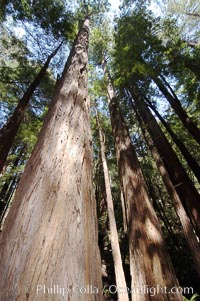
Coastal redwoods and Douglas firs dominate the Muir Woods National Monument north of San Francisco. Coast redwoods are the worlds tallest living species and second-most massive tree (after the giant Sequoia), reaching 370 ft in height and 22 ft in diameter. Muir Woods National Monument, Golden Gate National Recreation Area, north of San Francisco.
Species: Coastal redwood, Pseudotsuga menziesii, Sequoia sempervirens
Location: Muir Woods National Monument, California
Image ID: 09081
Species: Coastal redwood, Pseudotsuga menziesii, Sequoia sempervirens
Location: Muir Woods National Monument, California
Image ID: 09081

Coastal redwoods and Douglas firs dominate the Muir Woods National Monument north of San Francisco. Coast redwoods are the worlds tallest living species and second-most massive tree (after the giant Sequoia), reaching 370 ft in height and 22 ft in diameter. Muir Woods National Monument, Golden Gate National Recreation Area, north of San Francisco.
Species: Coastal redwood, Pseudotsuga menziesii, Sequoia sempervirens
Location: Muir Woods National Monument, California
Image ID: 09082
Species: Coastal redwood, Pseudotsuga menziesii, Sequoia sempervirens
Location: Muir Woods National Monument, California
Image ID: 09082

Coastal redwoods and Douglas firs dominate the Muir Woods National Monument north of San Francisco. Coast redwoods are the worlds tallest living species and second-most massive tree (after the giant Sequoia), reaching 370 ft in height and 22 ft in diameter. Muir Woods National Monument, Golden Gate National Recreation Area, north of San Francisco.
Species: Coastal redwood, Pseudotsuga menziesii, Sequoia sempervirens
Location: Muir Woods National Monument, California
Image ID: 09083
Species: Coastal redwood, Pseudotsuga menziesii, Sequoia sempervirens
Location: Muir Woods National Monument, California
Image ID: 09083

The General Sherman Sequoia tree is the largest (most massive) living thing on earth, standing over 275 feet tall with a 36 diameter and 102 circumference at its base. Its volume is over 53,000 cubic feet. It is estimated to be 2300 to 2700 years old.
Species: Giant sequoia tree, Sequoiadendron giganteum
Location: Giant Forest, Sequoia Kings Canyon National Park, California
Image ID: 09871
Species: Giant sequoia tree, Sequoiadendron giganteum
Location: Giant Forest, Sequoia Kings Canyon National Park, California
Image ID: 09871

The General Sherman Sequoia tree is the largest (most massive) living thing on earth, standing over 275 feet tall with a 36 diameter and 102 circumference at its base. Its volume is over 53,000 cubic feet. It is estimated to be 2300 to 2700 years old.
Species: Giant sequoia tree, Sequoiadendron giganteum
Location: Giant Forest, Sequoia Kings Canyon National Park, California
Image ID: 09872
Species: Giant sequoia tree, Sequoiadendron giganteum
Location: Giant Forest, Sequoia Kings Canyon National Park, California
Image ID: 09872
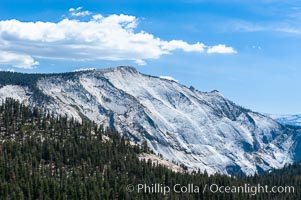
Clouds Rest viewed from Olmsted Point. Clouds Rest is one of the most massive -- if not the singlemost massive -- granite monoliths in the world. A vast lobe of Mesozoic-era granodiorite magma cooled to rock and was gradually uplifted to its present altitude of 9926 ft. Later, glaciers cut it into its present shape.
Location: Yosemite National Park, California
Image ID: 09961
Location: Yosemite National Park, California
Image ID: 09961

Clouds Rest viewed from Olmsted Point. Clouds Rest is one of the most massive -- if not the singlemost massive -- granite monoliths in the world. A vast lobe of Mesozoic-era granodiorite magma cooled to rock and was gradually uplifted to its present altitude of 9926 ft. Later, glaciers cut it into its present shape.
Location: Yosemite National Park, California
Image ID: 09962
Location: Yosemite National Park, California
Image ID: 09962
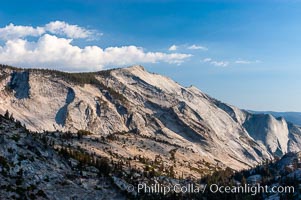
Clouds Rest viewed from Olmsted Point. Clouds Rest is one of the most massive -- if not the singlemost massive -- granite monoliths in the world. A vast lobe of Mesozoic-era granodiorite magma cooled to rock and was gradually uplifted to its present altitude of 9926 ft. Later, glaciers cut it into its present shape.
Location: Yosemite National Park, California
Image ID: 09963
Location: Yosemite National Park, California
Image ID: 09963

Snow geese gather in massive flocks over water, taking off and landing in synchrony.
Species: Snow goose, Chen caerulescens
Location: Bosque del Apache National Wildlife Refuge, New Mexico
Image ID: 19998
Species: Snow goose, Chen caerulescens
Location: Bosque del Apache National Wildlife Refuge, New Mexico
Image ID: 19998

Snow geese gather in massive flocks over water, taking off and landing in synchrony.
Species: Snow goose, Chen caerulescens
Location: Bosque del Apache National Wildlife Refuge, New Mexico
Image ID: 20001
Species: Snow goose, Chen caerulescens
Location: Bosque del Apache National Wildlife Refuge, New Mexico
Image ID: 20001

Snow geese gather in massive flocks over water, taking off and landing in synchrony.
Species: Snow goose, Chen caerulescens
Location: Bosque del Apache National Wildlife Refuge, New Mexico
Image ID: 20007
Species: Snow goose, Chen caerulescens
Location: Bosque del Apache National Wildlife Refuge, New Mexico
Image ID: 20007
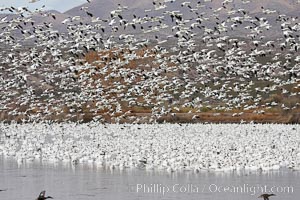
Snow geese gather in massive flocks over water, taking off and landing in synchrony.
Species: Snow goose, Chen caerulescens
Location: Bosque del Apache National Wildlife Refuge, New Mexico
Image ID: 20008
Species: Snow goose, Chen caerulescens
Location: Bosque del Apache National Wildlife Refuge, New Mexico
Image ID: 20008
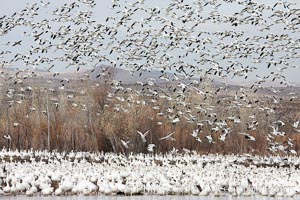
Snow geese gather in massive flocks over water, taking off and landing in synchrony.
Species: Snow goose, Chen caerulescens
Location: Bosque del Apache National Wildlife Refuge, New Mexico
Image ID: 20009
Species: Snow goose, Chen caerulescens
Location: Bosque del Apache National Wildlife Refuge, New Mexico
Image ID: 20009